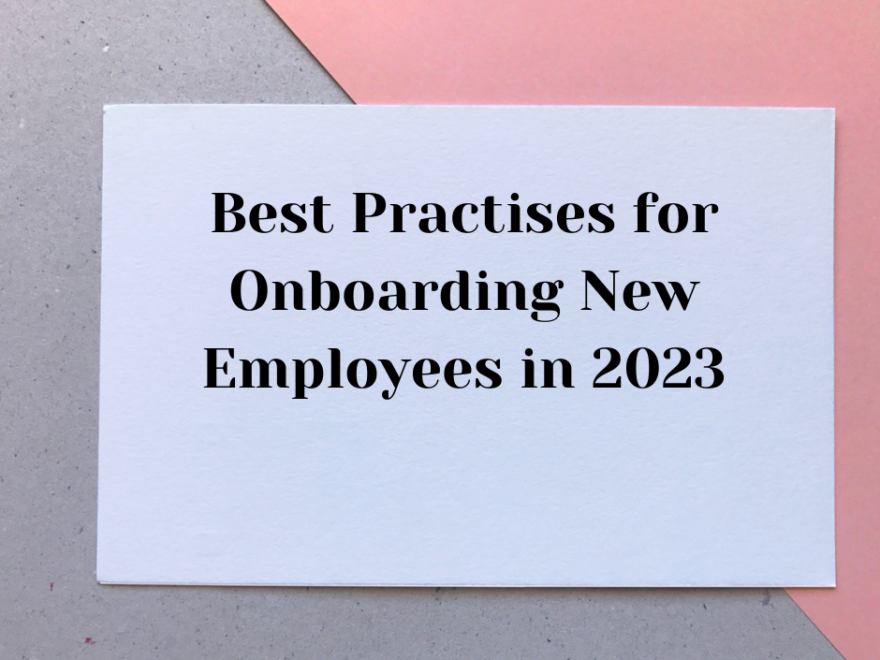The Introduction Today’s job market is highly competitive, so securing and maintaining top talent is a significant concern for businesses. An organized process for onboarding employees is essential to making a lasting and positive impression on new employees, ultimately affecting their performance and engagement.
As we move into 2023, the world of onboarding and HR has changed, and technology such as HRMS software is revolutionizing the onboarding experience. This post discusses the best ways to help new employees onboarding experience in 2023. In addition, we will explain how HRMS software can improve the effectiveness and efficiency of onboarding.
-
Facilitating improving the Onboarding Process:
One of the most effective practices for 2023 is to simplify the onboarding process so that new employees quickly be productive contributors. HRMS software streamlines and automates the various tasks associated with onboarding, like gathering personal information, filling out the necessary forms, and distributing essential training resources. By digitizing these processes, HR professionals can save time and energy while ensuring new employees enjoy an easy and smooth transition.
-
Preboarding Communication:
Preboarding, or the time between accepting an offer and the day employees start work, can be a fantastic chance to get new employees involved and help them get excited about their new position. HRMS software allows HR departments to customize greeting messages, videos of introduction, and other essential documents for new employees before their starting date. This proactive approach helps create an atmosphere of belonging and helps ease any fears about starting work, creating the foundation for a successful onboarding process.
-
Customized Onboarding Plan:
Every employee is different, and their experience onboarding must reflect the same. In 2023, companies will be using HRMS software to develop customized onboarding plans specific to each new employee’s specific role and duties. The plans could contain particular training courses related to the job and introductions to mentors and team members. By personalizing the process for onboarding, employers can improve employee engagement and help new employees feel valued from the beginning.
-
Electronic Documentation, and Compliance:
The traditional boarding process requires a lot of paperwork, which can be tedious and prone to mistakes. HRMS software streamlines the documentation process and allows new employees to fill out forms online, including tax documents, benefits enrollment, and the company’s policies. Furthermore, the software can detect and monitor that employees comply with employment rules and laws, ensuring that all documents required are secure and readily accessible.
-
Gaming and Interactive Onboarding:
To enhance the onboarding process by making it more fun and exciting, Organizations are now using elements of gamification and interactivity. HRMS systems often include features that allow interactive onboarding, such as tests, virtual workplace tours, and even onboarding challenges. Gamification is not only a fun factor but also aids new employees to grasp information more efficiently, leading to better knowledge retention.
-
Mentor/Buddy Programs:
Pairing new employees with their experienced colleagues as mentors or buddies is a suitable method of facilitating the onboarding process. HRMS software can help create and manage these programs, allowing new employees to establish relationships with their mentors before the start of their day. Having a friend or colleague who can seek guidance can significantly increase new employee retention and acceptance into the workplace culture.
-
Continuous feedback and evaluation:
In 2023, the onboarding process extends beyond the initial few hours or days of the job. HRMS software provides ongoing feedback and assessment, which allows supervisors and HR teams to frequently review new employees to learn about their experience and address any issues. Gathering feedback can help organizations determine areas that need improvement in their onboarding process and make the necessary adjustments to ensure future hires are successful.
-
Virtual onboarding:
Workers Remote work is the norm, and the need for virtual onboarding has become a must-have. HRMS software provides companies with an easy onboarding experience for remote employees by offering online access to all the necessary tools, such as remote training sessions and virtual team-building events. Virtual onboarding ensures that remote employees feel part of the corporate culture and are connected to their colleagues regardless of their geographical place of work.
Final:
In conclusion, the new process for onboarding employees in 2023 will be all about using technology to enhance methods to provide a pleasant and memorable experience for all new employees. HRMS software is integral in streamlining the onboarding process, from preboarding communications to customizing onboarding plans and digital documentation. Furthermore, gaming, buddy programs, constant feedback, and virtual onboarding of remote workers are some of the top practices businesses implement to boost retention and engagement.
In implementing these best practices and taking advantage of the features of an HRMS system, businesses can significantly improve their onboarding process, which leads to better employee satisfaction, higher efficiency, and, ultimately, an improved and more resilient workforce. As the landscape of business changes and changes, investing in a solid and efficient onboarding process based on technology becomes an essential aspect for businesses trying to attract and keep top talent through 2023 and beyond.

